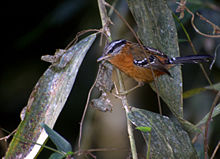Drymophila
| Drymophila | |
|---|---|

| |
| Ferruginous antbird (Drymophila ferruginea) | |
| Scientific classification | |
| Domain: | Eukaryota |
| Kingdom: | Animalia |
| Phylum: | Chordata |
| Class: | Aves |
| Order: | Passeriformes |
| Family: | Thamnophilidae |
| Tribe: | Pithyini |
| Genus: | Drymophila Swainson, 1824 |
| Species | |
|
See text | |
Drymophila is a bird genus in the antbird family (Thamnophilidae). It is a relative of the typical antwrens.
The genus Drymophila was introduced by the English naturalist William Swainson in 1824.[1] The type species is the ferruginous antbird.[2] The name of the genus combines the Ancient Greek words drumos for "wood" or "copse" and philos "fond of".[3]
Taxonomy and systematics
Extant species
The genus Drymophila contains the following eleven species:[4]
- Ferruginous antbird (Drymophila ferruginea)
- Bertoni's antbird (Drymophila rubricollis)
- Rufous-tailed antbird (Drymophila genei)
- Ochre-rumped antbird (Drymophila ochropyga)
- Dusky-tailed antbird (Drymophila malura)
- Scaled antbird (Drymophila squamata)
- Striated antbird (Drymophila devillei)
- Santa Marta antbird (Drymophila hellmayri)
- Klages's antbird (Drymophila klagesi)
- East Andean antbird (Drymophila caudata)
- Streak-headed antbird (Drymophila striaticeps)
Former species
Formerly, some authorities also considered the following species (or subspecies) as species within the genus Drymophila:
- Spectacled monarch (as Drymophila trivirgata)[5]
- Island monarch (as Drymophila cinerascens)[6]
- Shining flycatcher (as Drymophila alecto)[7]
Range
Six of the Drymophila species are associated with regions of southeastern Brazil; two of these - Bertoni's and dusky-tailed antbird - also range into eastern Paraguay and extreme northeastern Argentina.
Even at their highest diversity in Brazil's Mata Atlântica, the species are almost completely parapatric, in some cases like the dusky-tailed and scaled antbird even to exclusive habitat preferences. Of course, the rampant deforestation in that region may obscure that there has been more overlap in the past. In any case, habitat fragments strongly tend to hold at most a single species.[8]
D. devillei, the striated antbird, is a species of the southwestern quadrant of the Amazon Basin, and a disjunct population lives in north-western Ecuador and adjacent parts of Colombia.
Footnotes
- ^ Swainson, William John (1824). "An inquiry into the natural affinities of the Laniadae, or shrikes; preceded by some observations on the present state of ornithology in this country". Zoological Journal. 1: 289–307 [302].
- ^ Peters, James Lee, ed. (1951). Check-list of Birds of the World. Vol. Volume 7. Cambridge, Massachusetts: Museum of Comparative Zoology. p. 209.
{{cite book}}:|volume=has extra text (help) - ^ Jobling, James A. (2010). The Helm Dictionary of Scientific Bird Names. London: Christopher Helm. p. 140. ISBN 978-1-4081-2501-4.
- ^ Gill, Frank; Donsker, David, eds. (2018). "Antbirds". World Bird List Version 8.1. International Ornithologists' Union. Retrieved 3 February 2018.
- ^ "Symposiachrus trivirgatus - Avibase". avibase.bsc-eoc.org. Retrieved 2017-01-13.
- ^ "Monarcha cinerascens - Avibase". avibase.bsc-eoc.org. Retrieved 2017-01-18.
- ^ "Myiagra alecto - Avibase". avibase.bsc-eoc.org. Retrieved 2017-01-26.
- ^ Rajão & Cerqueira (2006)
References
- Rajão, Henrique & Cerqueira, Rui (2006): Distribuição altitudinal e simpatria das aves do gênero Drymophila Swainson (Passeriformes, Thamnophilidae) na Mata Atlântica [Elevational distribution and sympatry of birds of the genus Drymophila Swainson (Passeriformes, Thamnophilidae) in the Atlantic forest]. [Portuguese with English abstract] Revista Brasileira de Zoologia 23(3): 597–607. doi:10.1590/S0101-81752006000300002 PDF fulltext
